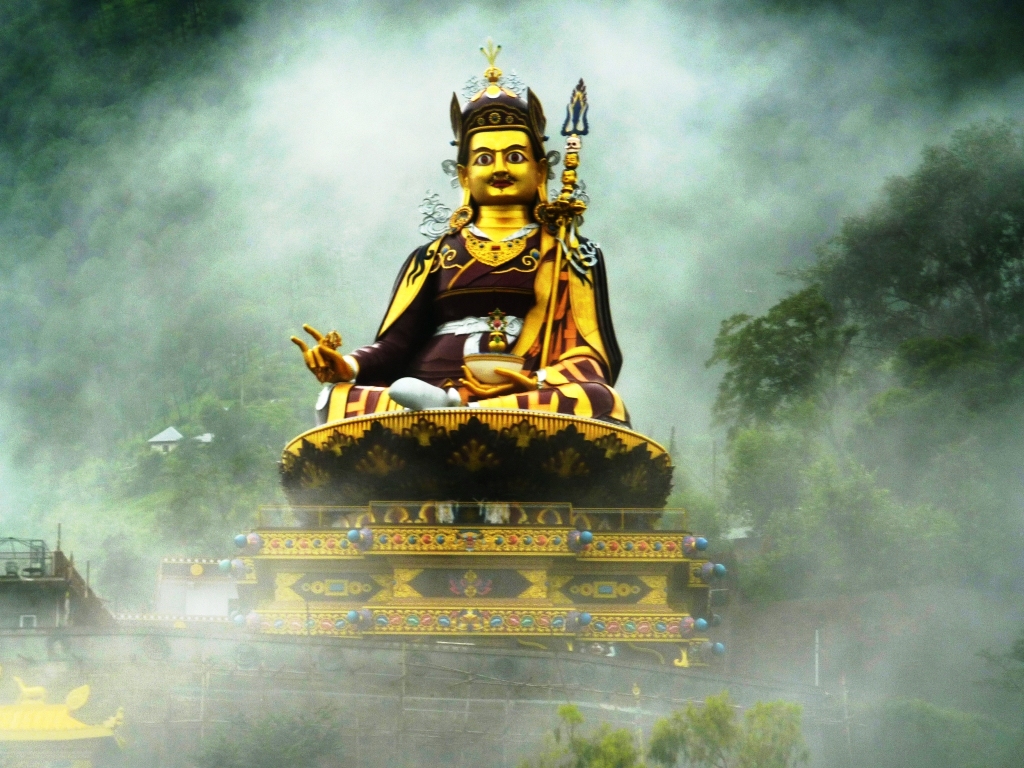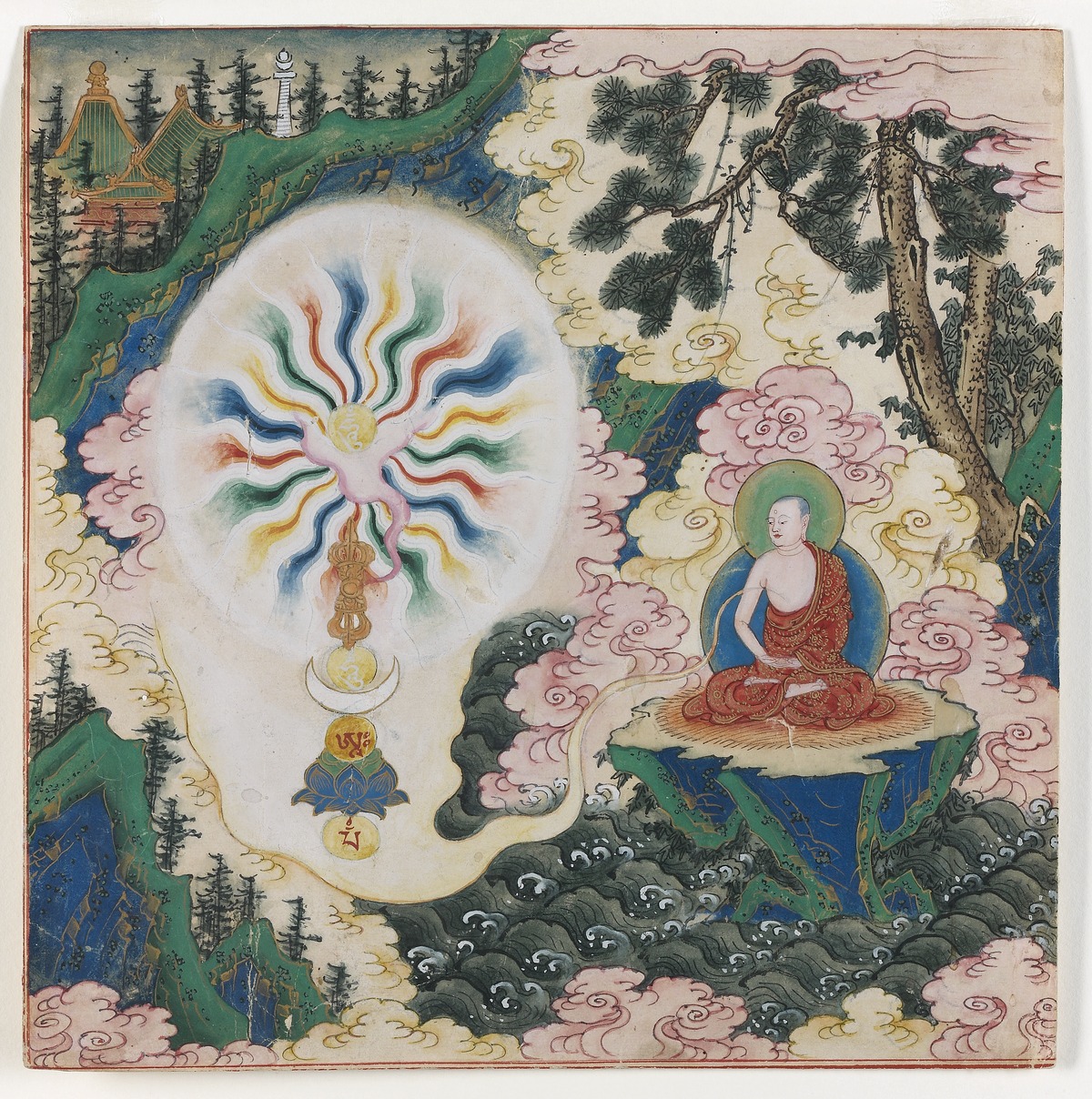|
Namkhai Nyingpo
sNub-Ben Namkha'i Nyingpo (, 8th/9th century) is counted amongst the principal "twenty-five disciples" () of Padmasambhava. sNub Ben Namkha'i Nyingpo was a realized practitioner of ┼Ü─üntarakß╣ŻitaŌĆÖs tradition of Sutrayana "gradualist" Mahayana Buddhism as well as simultaneously being one of the most accomplished Tibetan practitioners of the East Mountain Teaching of Chan Buddhism, which transmits the " subitist" tradition of Mahayana Buddhism. In addition, sNub Ben Namkha'i Nyingpo was also a realized master of Dzogchen as well as a Master of the Tantric path (Tantrayana), specifically, the three Outer Tantra yana and the Inner Tantra yana according to the Nyingma school of Tibetan Buddhism. Nomenclature, orthography and etymology Namkha'i Nyingpo's name may be rendered in English from the Tibetan as "essence of space", "matrix of the sky", "womb of space" and its Sanskrit form is ─Ćk─ü┼øagarbha. Biography sNub Ben Namkhai Nyingpo was born in Lower Nyal. He was one of the f ... [...More Info...] [...Related Items...] OR: [Wikipedia] [Google] [Baidu] |
Padmasambhava
Padmasambhava ("Born from a Lotus"), also known as Guru Rinpoche (Precious Guru) and the Lotus from OßĖŹßĖŹiy─üna, was a tantric Buddhist Vajra master from India who may have taught Vajrayana in Tibet (circa 8th ŌĆō 9th centuries)... According to some early Tibetan sources like the ''Testament of Ba'', he came to Tibet in the 8th century and helped construct Samye Monastery, the first Buddhist monastery in Tibet. However, little is known about the actual historical figure other than his ties to Vajrayana and Indian Buddhism. Padmasambhava later came to be viewed as a central figure in the transmission of Buddhism to Tibet. Starting from around the 12th century, hagiographies concerning Padmasambhava were written. These works expanded the profile and activities of Padmasambhava, now seen as taming all the Tibetan spirits and gods, and concealing various secret texts ('' terma'') for future tert├Čns. Nyangral Nyima ├¢zer (1124ŌĆō1192) was the author of the ''Zangling-ma'' (Jew ... [...More Info...] [...Related Items...] OR: [Wikipedia] [Google] [Baidu] |
Tantras
Tantras ("''doctrine''" or "''framework''" or "''system''" ) refers to numerous and varied scriptures pertaining to any of several esoteric traditions rooted in Hindu and Buddhist philosophy. The religious culture of the Tantras is essentially Hindu, and Buddhist Tantric material can be shown to have been derived from Hindu sources. And although Hindu and Buddhist Tantra have many similarities from the outside, they do have some clear distinctions. The rest of this article deals with Hindu Tantra. Buddhist Tantras are described in the article on Buddhist Tantras. Classes of Hindu Tantra The word ''tantra'' is made up by the joining (''sandhi'' in Sanskrit) of two Sanskrit words: ''tanoti'' (expansion) and ''rayati'' (liberation). Tantra means liberation of energy and expansion of consciousness from its gross form. It is a method to expand the mind and liberate the dormant potential energy, and its principles form the basis of all yogic practices. Hence, the Hindu Tantra scriptur ... [...More Info...] [...Related Items...] OR: [Wikipedia] [Google] [Baidu] |
Tibetan Empire
The Tibetan Empire (, ; ) was an empire centered on the Tibetan Plateau, formed as a result of imperial expansion under the Yarlung dynasty heralded by its 33rd king, Songtsen Gampo, in the 7th century. The empire further expanded under the 38th king, Trisong Detsen. The 821ŌĆō823 treaty concluded between the Tibetan Empire and the Tang dynasty delineated the former as being in possession of an area larger than the Tibetan Plateau, stretching east to Chang'an, west beyond modern Afghanistan, and south into modern India and the Bay of Bengal. The Yarlung dynasty was founded in 127 BC in the Yarlung Valley. The Yarlung capital was moved to Lhasa by the 33rd king Songsten Gampo, and into the Red Fort during the imperial period which continued to the 9th century. The beginning of the imperial period is marked in the reign of the 33rd king of the Yarlung dynasty, Songtsen Gampo. The power of Tibet's military empire gradually increased over a diverse terrain. During the reign of Tris ... [...More Info...] [...Related Items...] OR: [Wikipedia] [Google] [Baidu] |
Orgyen Lingpa
Orgyen Lingpa (''o rgyan gling pa''), (1323 ŌĆō 1360) was one of the greatest Tibetan tert├Čns or treasure-finders of the 14th century. Orgyen Lingpa discovered the important terma ''Pema Katang'' (''The Life and Liberation of Padmasambhava'') and many other important texts in the west-facing Pema Shelpuk cave near the entrance of the Yarlung Valley.Dudom Rinpoche, et al. (1999), Vol. 1, p. 775. Footnotes References * Dorje, Gyurme (1999). ''Footprint Tibet Handbook with Bhutan''. Footprint Handbooks, Bath, England. . * Dowman, Keith. (1988) ''The Power-Places of Central Tibet: The Pilgrim's Guide''. Routledge & Kegan Paul, London & New York. . * Dudjom Rinpoche (Jikdrel Yeshe Dorje) (1991). ''The Nyingmapa School of Tibetan Buddhism: Its Fundamentals and History''. 2 Vols. Translated and edited by Gyurme Dorje with Matthew Kapstein. Wisdom Publications. Boston. . {{DEFAULTSORT:Lingpa, Orgyen 1323 births 1360s deaths 14th-century Tibetan people History of Tib ... [...More Info...] [...Related Items...] OR: [Wikipedia] [Google] [Baidu] |
Terma (religion)
Terma (; "hidden treasure") are various forms of hidden teachings that are key to Vajrayana and Tibetan Buddhist and Bon spiritual traditions. In the Vajrayana Nyingma school tradition, two lineages occur: an oral ''kama'' lineage and a revealed ''terma'' lineage. Tradition holds that ''terma'' teachings were originally esoterically hidden by eighth-century Vajrayana masters Padmasambhava and Yeshe Tsogyal, to be discovered at auspicious times by treasure revealers known as tert├Čns. As such, terma represent a tradition of continuous revelation in Vajrayana and Tibetan Buddhism. Tradition Tradition holds that terma may be a physical object such as a text or ritual implement that is buried in the ground, hidden in a rock or crystal, secreted in a herb, or a tree, hidden in water, or hidden in the sky or in space. Though a literal understanding of ''terma'' is "hidden treasure", and sometimes refers to objects that are hidden away, the teachings associated should be understood as bei ... [...More Info...] [...Related Items...] OR: [Wikipedia] [Google] [Baidu] |
Siddhi
In Indian religions, (Sanskrit: '; fulfillment, accomplishment) are material, paranormal, supernatural, or otherwise magical powers, abilities, and attainments that are the products of yogic advancement through s─üdhan─üs such as meditation and yoga. The term ß╣øddhi (Pali: ''iddhi'', "psychic powers") is often used interchangeably in Buddhism. Etymology ''Siddhi'' is a Sanskrit noun which can be translated as "knowledge", "accomplishment", "attainment", or "success". Method The ''Visuddhimagga'' is one of the texts to give explicit details about how spiritual masters were thought to actually manifest supernormal abilities. It states that abilities such as flying through the air, walking through solid obstructions, diving into the ground, walking on water and so forth are achieved through changing one element, such as earth, into another element, such as air. The individual must master '' kasina'' meditation before this is possible. Dipa Ma, who trained via the Visuddhim ... [...More Info...] [...Related Items...] OR: [Wikipedia] [Google] [Baidu] |
Generation Stage
The fundamental practice of Vajrayana and Tibetan tantric practice, Tibetan tantra is deity yoga (''devatayoga''), meditation on a chosen deity or "cherished divinity" (Skt. ''Iß╣Żß╣Ła-devat─ü,'' Tib. ''yidam''), which involves the recitation of mantras, prayers and visualization of the deity, the associated mandala of the deity's pure land, Buddha field, along with consorts and attendant Buddhas and bodhisattvas. According to the Tibetan scholar Tsongkhapa, deity yoga is what separates Tantra from Sutra practice. In the Unsurpassed Yoga Tantras, the most widespread tantric form in Indo-Tibetan Buddhism, this method is divided into two stages, the generation stage (''utpatti-krama'') and the completion stage (''nispanna-krama''). In the generation stage, one dissolves one's reality into emptiness and meditates on the deity-mandala, resulting in identification with this divine reality. In the completion stage, the divine image along with the subtle body is applied to the realizat ... [...More Info...] [...Related Items...] OR: [Wikipedia] [Google] [Baidu] |
Dalai Lama
Dalai Lama (, ; ) is a title given by the Tibetan people to the foremost spiritual leader of the Gelug or "Yellow Hat" school of Tibetan Buddhism, the newest and most dominant of the four major schools of Tibetan Buddhism. The 14th and current Dalai Lama is Tenzin Gyatso, who lives as a refugee in India. The Dalai Lama is also considered to be the successor in a line of tulkus who are believed to be incarnations of Avalokite┼øvara, the Bodhisattva of Compassion. Since the time of the 5th Dalai Lama in the 17th century, his personage has always been a symbol of unification of the state of Tibet, where he has represented Buddhist values and traditions. The Dalai Lama was an important figure of the Geluk tradition, which was politically and numerically dominant in Central Tibet, but his religious authority went beyond sectarian boundaries. While he had no formal or institutional role in any of the religious traditions, which were headed by their own high lamas, he was a unifying sym ... [...More Info...] [...Related Items...] OR: [Wikipedia] [Google] [Baidu] |
Dilgo Khyentse Rinpoche
Tashi Paljor, Dilgo Khyentse Rinpoche () (c. 1910 ŌĆō 28 September 1991) was a Vajrayana master, scholar, poet, teacher, and recognized by Buddhists as one of the greatest realized masters. Head of the Nyingma school of Tibetan Buddhism from 1988 to 1991, he is also considered an eminent proponent of the Rime tradition. As the primary custodian of the teachings of Jamyang Khyentse Wangpo, Dilgo Khyentse was the de facto custodian of the vast majority of Tibetan Buddhist teachings. He taught many eminent teachers, including the Dalai Lama. After the Chinese invasion of Tibet, his personal effort was crucial in the preservation of Tibetan Buddhism. Biography Early life, ancestry He was born in 1910 in the Denhok Valley at Kham Derge, Eastern Tibet, to a family directly descended from the ninth-century King Trisong Detsen. His father was a minister to the King of Derge. When he was seven years old, he was publicly recognized as one of the reincarnations of Jamyang Khyentse Wangpo ... [...More Info...] [...Related Items...] OR: [Wikipedia] [Google] [Baidu] |
Karmapa
The Karmapa (honorific title '' His Holiness the Gyalwa'' ĮóÓŠÆÓŠ▒ÓĮŻÓ╝ŗÓĮ¢Ó╝ŗ, Victorious One''Karmapa'', more formally as ''Gyalwang'' ĮóÓŠÆÓŠ▒ÓĮŻÓ╝ŗÓĮæÓĮ¢ÓĮäÓ╝ŗÓĮĆÓĮóÓŠ©Ó╝ŗÓĮöÓ╝ŗ, King of Victorious Ones''Karmapa'', and informally as the ''Karmapa Lama'') is the head of the Karma Kagyu, the largest sub-school of the Kagyu (ÓĮ¢ÓĮĆÓĮĀÓ╝ŗÓĮ¢ÓĮóÓŠÆÓŠ▒ÓĮ┤ÓĮæ, ), itself one of the four major schools of Tibetan Buddhism. Karmapa was Tibet's first consciously incarnating lama. The historical seat of the Karmapas is Tsurphu Monastery in the Tolung valley of Tibet. The Karmapa's principal seat in exile is the Dharma Chakra Centre at Rumtek Monastery in Sikkim, India. His regional monastic seats are Karma Triyana Dharmachakra in New York and Dhagpo Kagyu Ling in Dordogne, France. Due to a controversy within the Karma Kagyu school over the recognition process, the identity of the current 17th Karmapa is disputed by some. See Karmapa controversy for details. Origin of the lineage ... [...More Info...] [...Related Items...] OR: [Wikipedia] [Google] [Baidu] |



